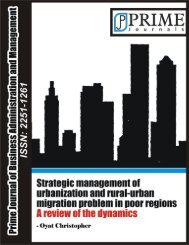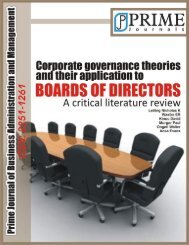Mungai et al.pdf - Prime Journals
Mungai et al.pdf - Prime Journals
Mungai et al.pdf - Prime Journals
Create successful ePaper yourself
Turn your PDF publications into a flip-book with our unique Google optimized e-Paper software.
899 Prim. J. Bus. Admin. Manage.NSSF and 0.7 billion by non-bank investors (NSE, 2011).Foreign currenciesThe mark<strong>et</strong> for foreign exchange involves the purchaseand s<strong>al</strong>e of nation<strong>al</strong> currencies (Gans <strong>et</strong> <strong>al</strong>., 2009). Aforeign exchange mark<strong>et</strong> exists because economiesemploy nation<strong>al</strong> currencies. If the world economy used asingle currency there would be no need for foreignexchange mark<strong>et</strong>s. Foreign exchange is the world‟slargest and most actively traded mark<strong>et</strong>. Each day mor<strong>et</strong>han USD 3 trillion changes hands. This is only possiblebecause of the mark<strong>et</strong>‟s profession<strong>al</strong> and efficientorganization. Moreover, the currency mark<strong>et</strong> is becomingmore and more transparent, despite its size.Glob<strong>al</strong>ization is integrating the glob<strong>al</strong> economy, and thereare fewer and fewer pegged exchange rates. The numberof non tradable currencies is <strong>al</strong>so declining, according tothe world Trade Organization report (2011). This meansthat, in addition to tradition<strong>al</strong> currencies, new investmentopportunities are <strong>al</strong>so emerging in growth mark<strong>et</strong>s suchas Asia and Latin America. Investing in foreign exchangemeans investing in the economic development of acountry or group of countries. Factors such as GDPdevelopment, trade b<strong>al</strong>ances, interest rates, industri<strong>al</strong>output, and the politic<strong>al</strong> stability of a country or region <strong>al</strong>lhave a decisive effect on exchange rates. Foreignexchange investments are no longer the preserve oflarge investors. Since the minimum amounts for foreignexchange investments are f<strong>al</strong>ling, private investors canincreasingly take advantage of the opportunities offeredby these products. Investment horizons can range from asingle day to sever<strong>al</strong> years. As a separate ass<strong>et</strong> class,foreign exchange investments make an ide<strong>al</strong> portfoliosupplement. They offer investors attractive instrumentswith which to actively manage their portfolios (Heath andTversky, 1991).CommoditiesSince early 2000s, commodity futures have emerged as apopular ass<strong>et</strong> class for many financi<strong>al</strong> institutions.According to United States Department of the Treasury(2010), the tot<strong>al</strong> v<strong>al</strong>ue of various commodity index-relatedinstruments purchased by institution<strong>al</strong> investors hadincreased from an estimated $15 billion in 2003 to atleast $200 billion in mid-2008. Various observers, policymakers and the US Department of Treasury expressed astrong concern that index investment as A form offinanci<strong>al</strong> speculation might have caused unwarrantedincreases in the cost of energy and food and inducedexcessive price volatility. What is the economic impact ofthe rapid growth of commodity index investment? Toaddress this question, it is important to recognize theconcurrent economic transition of commodities mark<strong>et</strong>sprecipitated by the rapid growth of commodity indexinvestment. Prior to early 2000s, despite liquid futurescontracts traded on many commodities, their pricesprovided risk premium for idiosyncratic commodity pricerisk and had little movements with stocks and with eachother (Fellner and Maciejovsk, 2007). These aspects arein sharp contrast to price dynamics of typic<strong>al</strong> financi<strong>al</strong>ass<strong>et</strong>s, which carry premium only for systematic risk andare highly correlated with mark<strong>et</strong> indices and with eachother. This contrast indicates that commodities mark<strong>et</strong>swere parti<strong>al</strong>ly segmented from outside financi<strong>al</strong> mark<strong>et</strong>sand from each other. Recognition of potenti<strong>al</strong>diversification benefits from investing in the segmentedcommodities mark<strong>et</strong>s prompted the rapid growth ofcommodity index investment after early 2000s andprecipitated a fundament<strong>al</strong> process of financi<strong>al</strong>izationamongst commodities mark<strong>et</strong>s.Individu<strong>al</strong> savings accountAn Individu<strong>al</strong> Savings Account (ISA) is designed for thepurpose of investment and savings with a favourable taxstatus. Money is contributed from after tax income andnot subjected to income tax or capit<strong>al</strong> gains tax within aholding or upon withdraw<strong>al</strong>. Cash and a broad range ofinvestments can be held and there is no restriction onwhen or how much money can be withdrawn. Fundscannot be used as security for a loan. It is not a pensionproduct but can be a useful complement to a pension forr<strong>et</strong>irement income, particularly when it is desirable todraw down capit<strong>al</strong> at a faster rate than permitted in apension (Dash, 2010).Endowment policyAn endowment policy is a life insurance contractdesigned to pay a lump sum after a specified term (on its'maturity') or on death. Typic<strong>al</strong> maturities are ten, fifteenor twenty years up to a certain age limit. Some policies<strong>al</strong>so pay out in the case of critic<strong>al</strong> illness. Policies ar<strong>et</strong>ypic<strong>al</strong>ly tradition<strong>al</strong> with-profits or unit-linked (includingthose with unitised with-profits funds). Endowments canbe cashed in early (or surrendered) and the holder thenreceives the surrender v<strong>al</strong>ue which is d<strong>et</strong>ermined by theinsurance company depending on how long the policyhas been running and how much has been paid in to it(Allen and Faulhaber, 1989).Most endowment policies are established for a s<strong>et</strong>period (the policy term) of 10 years or more, this isbecause advantageous taxation rules apply to LifeAssurance policies with terms of 10 years or more. Thes<strong>et</strong>axation rules (c<strong>al</strong>led the Qu<strong>al</strong>ifying rules) <strong>al</strong>low for anyinvestment gains made within suitable policies, c<strong>al</strong>ledQu<strong>al</strong>ifying policies, to be paid to the policyholder withoutany person<strong>al</strong> tax being deducted. As endowment policiesare Life Assurance policies then a term for the policymust be established at outs<strong>et</strong>. Although it is possible forpolicies to have terms of less than 10 years, this is quiterare.Where the policy premiums are invested will differ inaccordance with the policy type. The majority of suchpolicies are 'With Profits'. In these instances the policypremiums are invested in the With Profits fund of the Life





![See Full Article [pdf] - prime journals limited](https://img.yumpu.com/49292987/1/190x245/see-full-article-pdf-prime-journals-limited.jpg?quality=85)



![See Full Article [pdf] - Prime Journals](https://img.yumpu.com/44526114/1/190x245/see-full-article-pdf-prime-journals.jpg?quality=85)

![See Full Article [pdf] - prime journals limited](https://img.yumpu.com/42270022/1/190x245/see-full-article-pdf-prime-journals-limited.jpg?quality=85)

![See Full Article [pdf] - Prime Journals](https://img.yumpu.com/41607332/1/190x245/see-full-article-pdf-prime-journals.jpg?quality=85)
![See Full Article [pdf] - Prime Journals](https://img.yumpu.com/41231982/1/190x245/see-full-article-pdf-prime-journals.jpg?quality=85)

